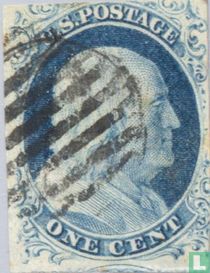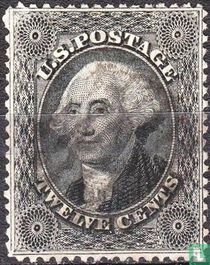Postzegels uit Verenigde Staten van Amerika (USA) catalogus
De Verenigde Staten van Amerika is een land in Noord-Amerika, aan de Atlantische Oceaan en de Stille Oceaan. De Verenigde Staten geven postzegels uit sinds 1847. Ze werden niet alleen gebruikt in de toenmalige 29 staten, maar ook in de territoria. Lees verder
Postzegels uit Verenigde Staten van Amerika
De Verenigde Staten van Amerika is een land in Noord-Amerika, aan de Atlantische Oceaan en de Stille Oceaan. De Verenigde Staten geven postzegels uit sinds 1847. Ze werden niet alleen gebruikt in de toenmalige 29 staten, maar ook in de territoria. Later claimden de Verenigde Staten de toen nog onbewoonde eilanden Baker, Howland, Jarvis en Navassa (1857), Johnston (1858), Midway (1859), Kingman (1860) en Wake (1898) als Amerikaanse territoria. Vanaf 1861 gaven de afgescheiden Geconfedereerde Staten van Amerika eigen postzegels uit, tot ze verslagen werden in 1865. In 1867 kochten de Verenigde Staten de Russische kolonie Russisch-Amerika, vanaf dan het departement (en de latere staat) Alaska. In 1899 werd Tutuila (sinds 1911 Amerikaans-Samoa) een Amerikaans territorium. De territoria Hawaï en Puerto Rico gebruiken Amerikaanse postzegels sinds 1900, Guam sinds 1901. In 1917 kochten de Verenigde Staten de kolonie Deens-West-Indië van Denemarken, sindsdien het territorium van de Amerikaanse Maagdeneilanden. De Verenigde Staten bezetten tijdens de 2de Wereldoorlog in 1944 het Japans Zuid-Pacifisch Mandaatgebied, dat in 1947 officieel werd omgevormd tot het Trustgebied van de Pacifische Eilanden, een Amerikaans trustgebied van de Verenigde Naties. Vanaf 1983 gaf Palau eigen postzegels uit en vanaf 1984 Micronesië en de Marshalleilanden, maar de Noordelijke Marianen blijven Amerikaanse postzegels gebruiken.
FLAT PLATE PRINTING
Flat plate press was initially used for printing all stamps of the United States. The first engraved plates used for this purpose in 1847 contained 200 subjects. The number of subjects to a plate varied between 100 and 300 until the issue of 1890, when the 400-subject plate was first laid down. Since that time, this size of plate has been used for a majority of the regular postal issues (those other than commemoratives).
Most stamps were printed and sold by postmasters in whole sheets, which means that sheets, per se, are not uncommon. Because the resulting sizes were often so large as to make them unwieldy, these large sheets were typically cut into counter sheets, also called panes.
The sheets of many classic U.S. stamps had only two panes, many of the Bureau issues had four panes, while modern sheets may have six or more panes. A white margin surrounds the stamps on the four sides.
Voids called gutters separated the panes, giving printers waste-free areas within which to make their cuts. When it comes to the traditional, perforated sheets, collectors look for the colored sheet numbers in the margin or gutter, which can identify a sheet by its plate block, as well as its print run.
In a typical 400-subject plate there were guide-lines: horizontal or vertical colorde lines, extending wholly or partially across the sheet. They serve as guides for the operators of perforating machines or to indicate the point of separation of the sheet into panes.
When guide lines are used to mark the division of the sheet into panes, the space between the stamps at the edge of the pane is no different than the space between any other stamps on the sheet. Some plates provide a wide space, or gutter, between the panes. These plates do not produce guide lines.
As a result of cutting sheets in two or four panes, these panes always contain two imperforate sides:
Pane 1: one on the right side and one at the bottom;
Pane 2: one on the right side and one at the top;
Pane 3: one on the left side and one at the bottom;
Pane 4: one on the left side and one on the top
Stamps in the corners always have two sides imperforate.
The rotary press printing was developed in 1910 and first production took place in 1914. Because of the curved plates of the rotary press cylinders, the rotary impressions are somewhat larger.
Sources of information for USA background pages :
Scott Specialized Catalogue of United States Stamps & Covers
Stanley Gibbons Stamp Catalogue part 22 United States
https://www.collectorsweekly.com/stamps/sheets
https://postalmuseum.si.edu/library
https://www.theswedishtiger.com/
https://stampsmarter.org/index.html
Mystic Stamp Company
https://fr.wikipedia.org/wiki/
FILIGRANES – WATERMARKS
F
a) seulement pour les timbres-poste
Entre le 25 avril 1895 et le 25 septembre 1909, un filigrane feuillet a été utilisé avec les lettres à ligne double U S P S. (“United States Postage Stamp”) ou (Timbre-poste des Etats-Unis). Ces lettres ont été réparties sur une feuille entière dans deux orientations différentes: une version « pas en arrière » dans laquelle chaque rangée de lettres commence par une lettre à gauche de la rangée, et une deuxième version, appelée « pas en avant », dans laquelle chaque rangée de lettres commence par une lettre à droite de la rangée dessus.
Une lettre peut être vue complètement ou partiellement sur chaque timbre, et parfois des parties de deux lettres.Du 1er octobre 1910 au 23 septembre 1915, un filigrane feuillet est utilisé avec les lettres à ligne unique U S P S réparties sur une feuille entière comme pour 1.
b) seulement pour les cartes postales :
Entre 1873 et 1875, le monogramme U S P O D a été utilisé comme filigrane sur les cartes postales.
E
a) only for postage stamps
From April 1895 to 25th of September 1909, a sheet watermark was used with the double-lined letters U S P S. The letters, standing for “United States Postage Stamp”, were spread over a whole sheet in two different orientations: a “backward-stepping” version in which each row of letters begins one letter to the left of the row, and a second variety, called a ”foreward-stepping” variety, in which each row of letters begins one letter to the right of the row above.
A letter can be seen completely or partially on each stamp, and sometimes parts of two letters.From the 1th of October 1910 to the 23th of September 1915, a sheet watermark was used with the single-lined letters U S P S spread over a whole sheet as for 1.
b) only for postal cards:
Between 1873 and 1875 the monogram U S P O D was used as watermark on postal cards.
N.B. The use of illustrations isn’t yet available on this background page. Those illustrations would have been very useful and would have made the text more understandable.




























































